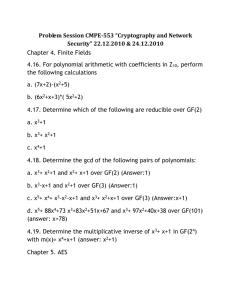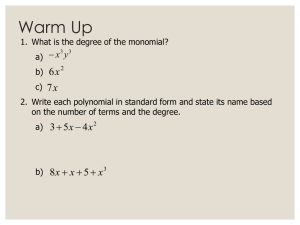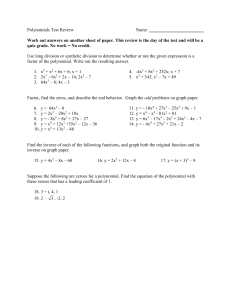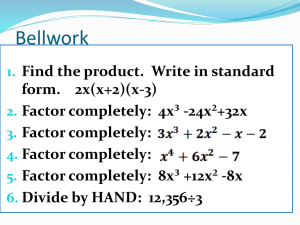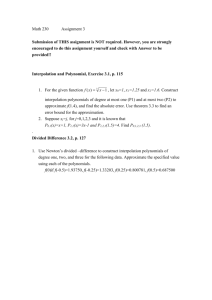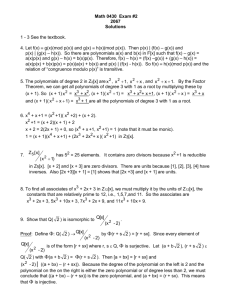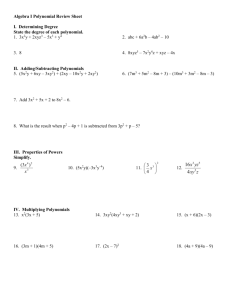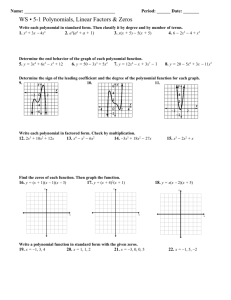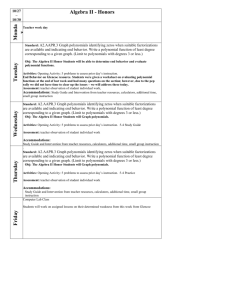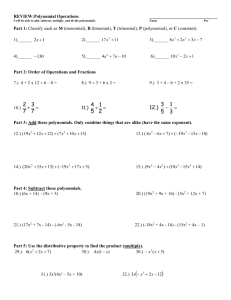SecondaryIII Pacing Guide Block 2
advertisement
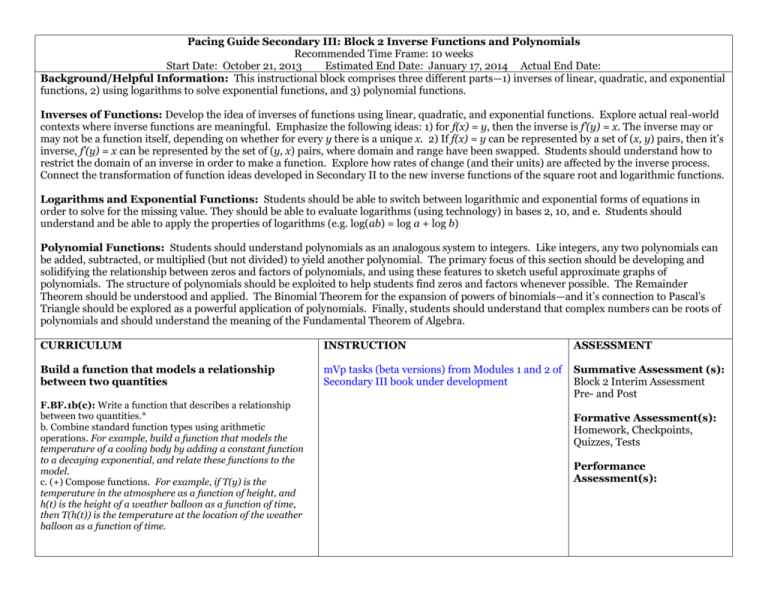
Pacing Guide Secondary III: Block 2 Inverse Functions and Polynomials Recommended Time Frame: 10 weeks Start Date: October 21, 2013 Estimated End Date: January 17, 2014 Actual End Date: Background/Helpful Information: This instructional block comprises three different parts—1) inverses of linear, quadratic, and exponential functions, 2) using logarithms to solve exponential functions, and 3) polynomial functions. Inverses of Functions: Develop the idea of inverses of functions using linear, quadratic, and exponential functions. Explore actual real-world contexts where inverse functions are meaningful. Emphasize the following ideas: 1) for f(x) = y, then the inverse is f’(y) = x. The inverse may or may not be a function itself, depending on whether for every y there is a unique x. 2) If f(x) = y can be represented by a set of (x, y) pairs, then it’s inverse, f’(y) = x can be represented by the set of (y, x) pairs, where domain and range have been swapped. Students should understand how to restrict the domain of an inverse in order to make a function. Explore how rates of change (and their units) are affected by the inverse process. Connect the transformation of function ideas developed in Secondary II to the new inverse functions of the square root and logarithmic functions. Logarithms and Exponential Functions: Students should be able to switch between logarithmic and exponential forms of equations in order to solve for the missing value. They should be able to evaluate logarithms (using technology) in bases 2, 10, and e. Students should understand and be able to apply the properties of logarithms (e.g. log(ab) = log a + log b) Polynomial Functions: Students should understand polynomials as an analogous system to integers. Like integers, any two polynomials can be added, subtracted, or multiplied (but not divided) to yield another polynomial. The primary focus of this section should be developing and solidifying the relationship between zeros and factors of polynomials, and using these features to sketch useful approximate graphs of polynomials. The structure of polynomials should be exploited to help students find zeros and factors whenever possible. The Remainder Theorem should be understood and applied. The Binomial Theorem for the expansion of powers of binomials—and it’s connection to Pascal’s Triangle should be explored as a powerful application of polynomials. Finally, students should understand that complex numbers can be roots of polynomials and should understand the meaning of the Fundamental Theorem of Algebra. CURRICULUM INSTRUCTION ASSESSMENT Build a function that models a relationship between two quantities mVp tasks (beta versions) from Modules 1 and 2 of Secondary III book under development Summative Assessment (s): Block 2 Interim Assessment Pre- and Post F.BF.1b(c): Write a function that describes a relationship between two quantities.* b. Combine standard function types using arithmetic operations. For example, build a function that models the temperature of a cooling body by adding a constant function to a decaying exponential, and relate these functions to the model. c. (+) Compose functions. For example, if T(y) is the temperature in the atmosphere as a function of height, and h(t) is the height of a weather balloon as a function of time, then T(h(t)) is the temperature at the location of the weather balloon as a function of time. Formative Assessment(s): Homework, Checkpoints, Quizzes, Tests Performance Assessment(s): Build new functions from existing functions F.BF.3: Identify the effect on the graph of replacing f(x) by f(x) + k, kf(x), f(kx), and f(x + k) for specific values of k (both positive and negative); find the value of k given the graphs. Experiment with cases and illustrate an explanation of the effects on the graph using technology. Include recognizing even and odd functions from their graphs and algebraic expressions for them. F.BF. 4a(cd): Find inverse functions. a. Solve an equation of the form f(x) = c for a simple function f that has an inverse and write an expression for the inverse. For example, f(x) = 2x3 or f(x) = (x+1)/(x-1) for x ≠ 1. [Limit to inverses of linear, exponential and quadratic in this block.] c. (+) Read values of an inverse function from a graph or a table given that the function has an inverse. d. (+) Produce an invertible function from a non-invertible function by restricting the domain. F.BF.5 (+): Understand the inverse relationship between exponents and logarithms and use this relationship to solve problems involving logarithms and exponents. Construct and compare linear, quadratic, and exponential models and solve problems F.LE.4: For exponential models, express as a logarithm the solution to abct = d where a, c, and d are numbers and the base b is 2, 10, or e; evaluate the logarithm using technology. Interpret the structure of expressions A.SSE.1ab: Interpret expressions that represent a quantity in terms of its context.* a. Interpret parts of an expression, such as terms, factors, and coefficients. b. Interpret complicated expressions by viewing one or more of their parts as a single entity. For example, interpret P(1+ r)n as the product of P and a factor not depending on P. A.SSE.2: Use the structure of an expression to identify ways to rewrite it. For example, see x4 – y4 as (x2)2 – (y2)2, thus recognizing it as a difference of squares that can be factored as (x2 – y2)(x2 + y2). Perform arithmetic operations on polynomials. A.APR.1: Understand that polynomials form a system analogous to the integers, namely, they are closed under the operations of addition, subtraction, and multiplication; add, subtract, and multiply polynomials. Understand the relationship between zeros and factors of polynomials. A.APR.2: Know and apply the Remainder Theorem: For a polynomial p(x) and a number a, the remainder on division by x – a is p(a), so p(a) = 0 if and only if (x – a) is a factor of p(x). A.APR.3: Identify zeros of polynomials when suitable factorizations are available, and use the zeros to construct a rough graph of the function defined by the polynomial. Use polynomial identities to solve problems. A.APR.4: Prove polynomial identities and use them to describe numerical relationships. For example, the polynomial identity (x2 + y2)2 = (x2 – y2)2 + (2xy)2 can be used to generate Pythagorean triples. A.APR.5 (+): Know and apply the Binomial Theorem for the expansion of (x + y)n in powers of x and y for a positive integer n, where x and y are any numbers, with coefficients determined for example by Pascal’s Triangle. Analyze functions using different representations F.IF.7c: Graph functions expressed symbolically and show key features of the graph, by hand in simple cases and using technology for more complicated cases.* c. Graph polynomial functions, identifying zeros when suitable factorizations are available, and showing end behavior. Use complex numbers in polynomial identities and equations. N.CN.8 (+): Extend polynomial identities to the complex numbers. For example, rewrite x2 + 4 as (x+2i)(x-2i). N.CN.9 (+): Know the Fundamental Theorem of Algebra; show that it is true for quadratic polynomials. Related Standards: F.IF.4, F.IF.5
